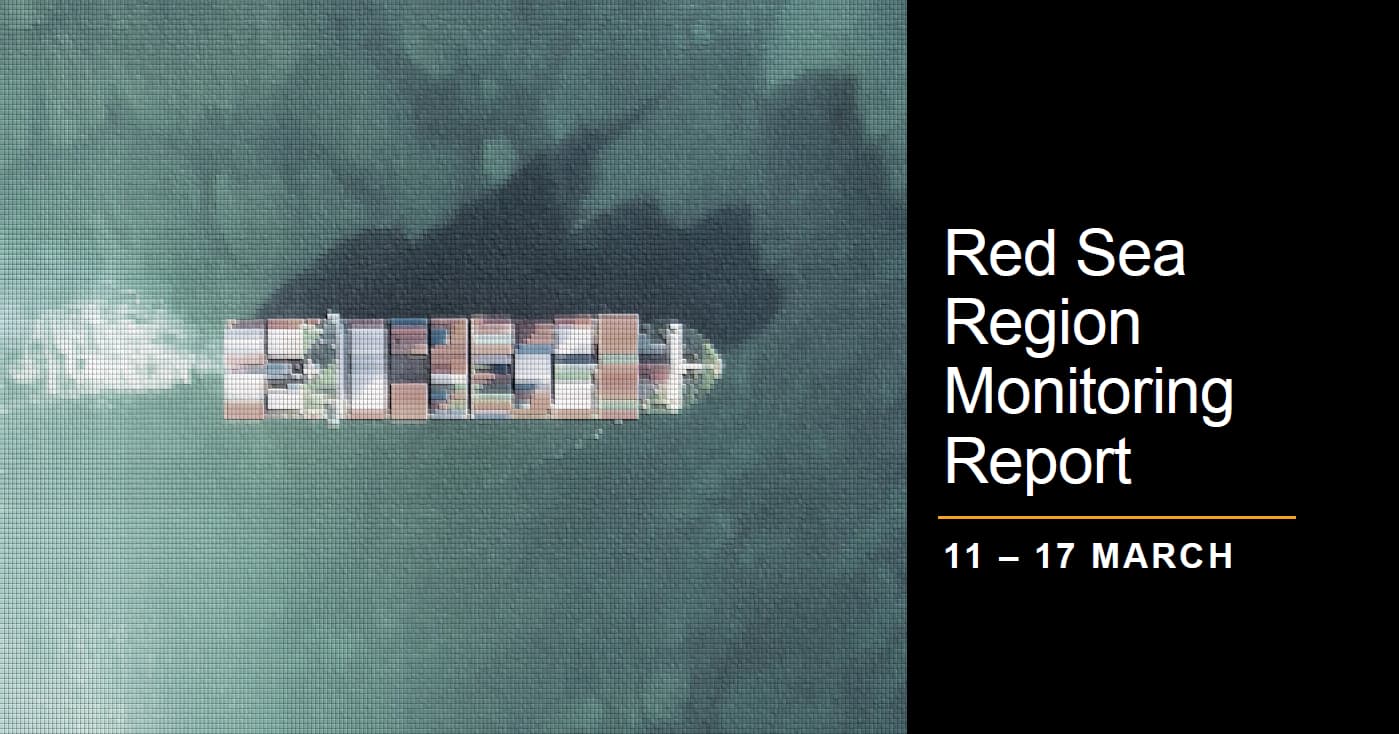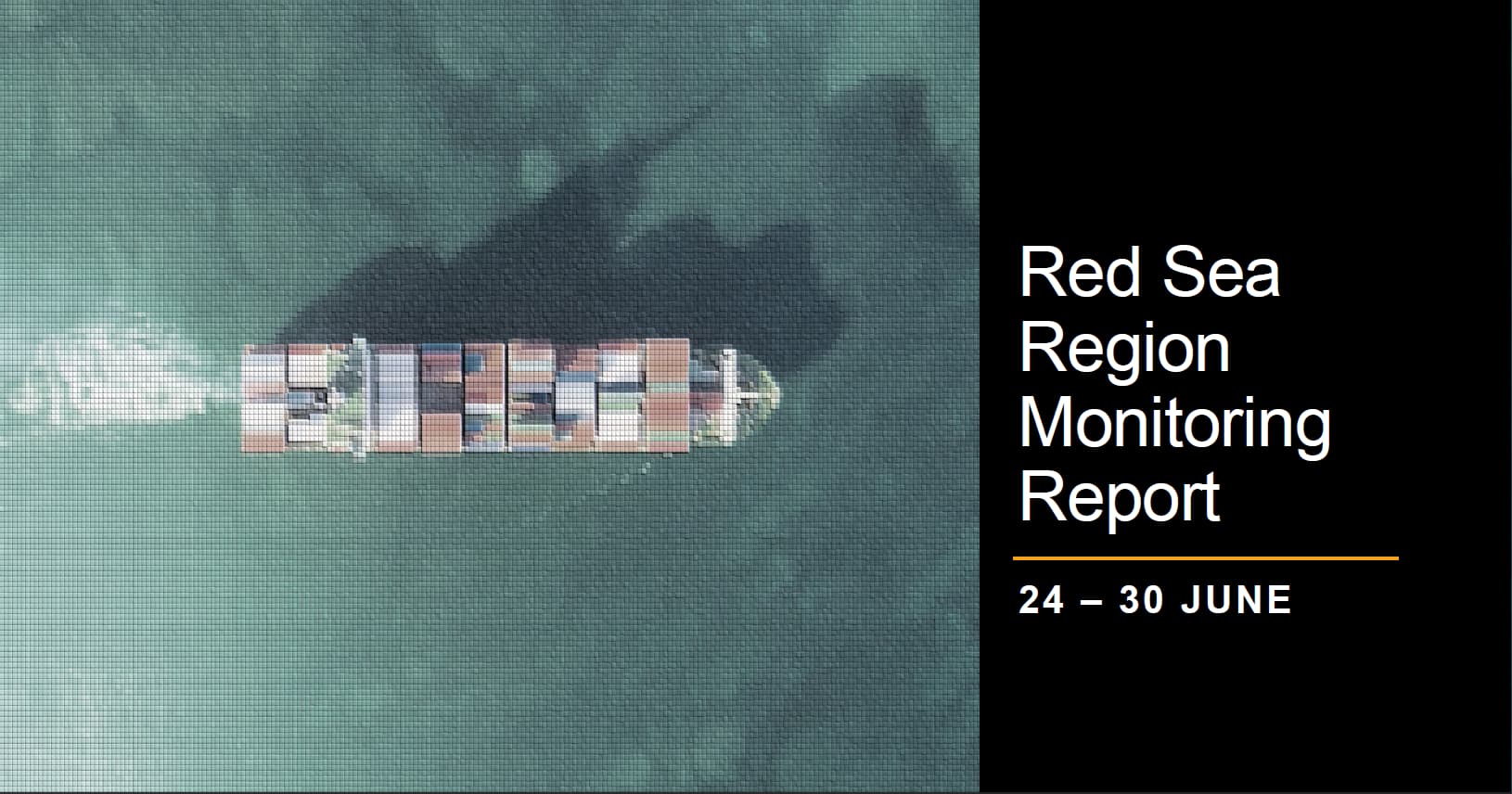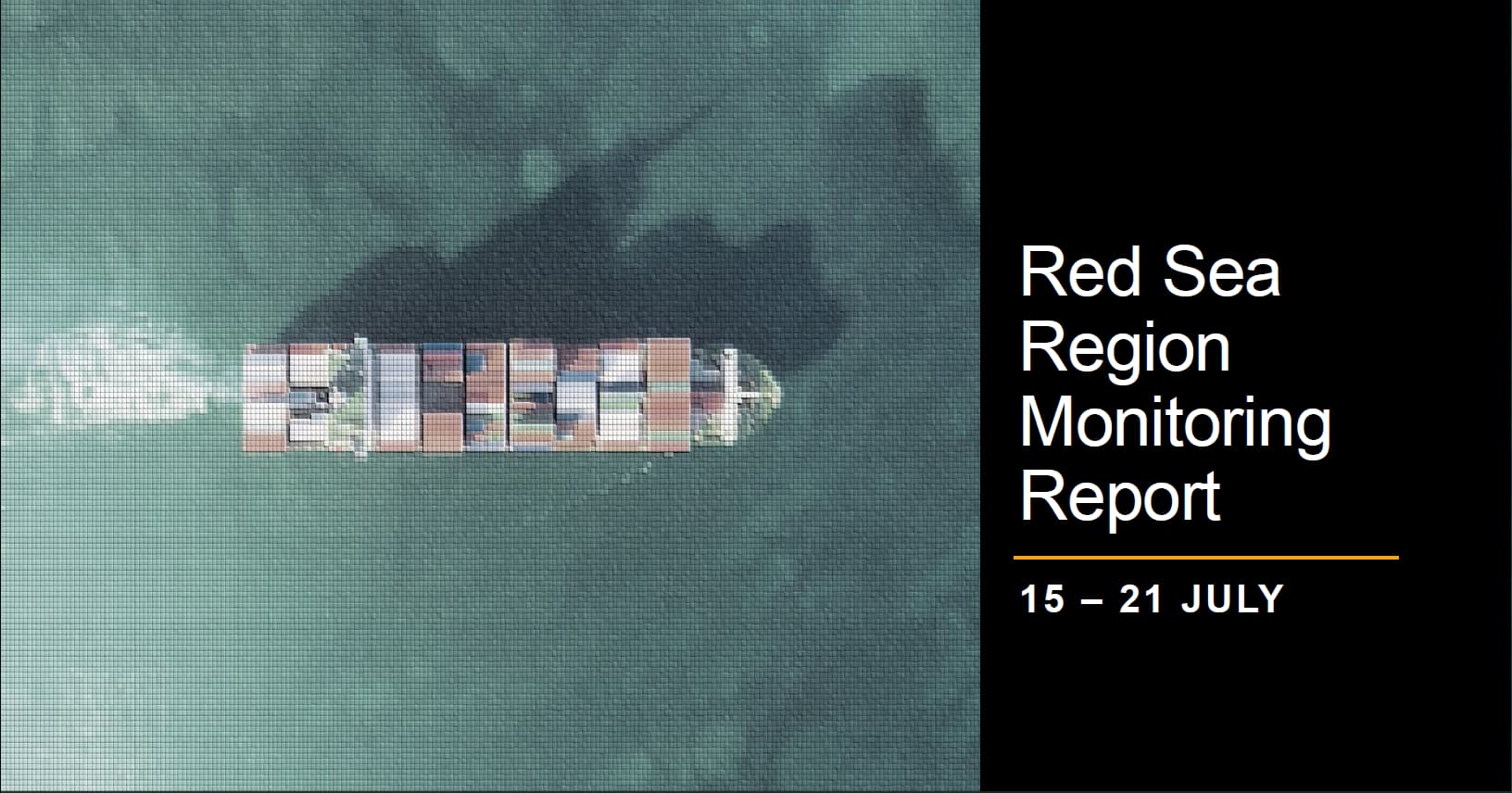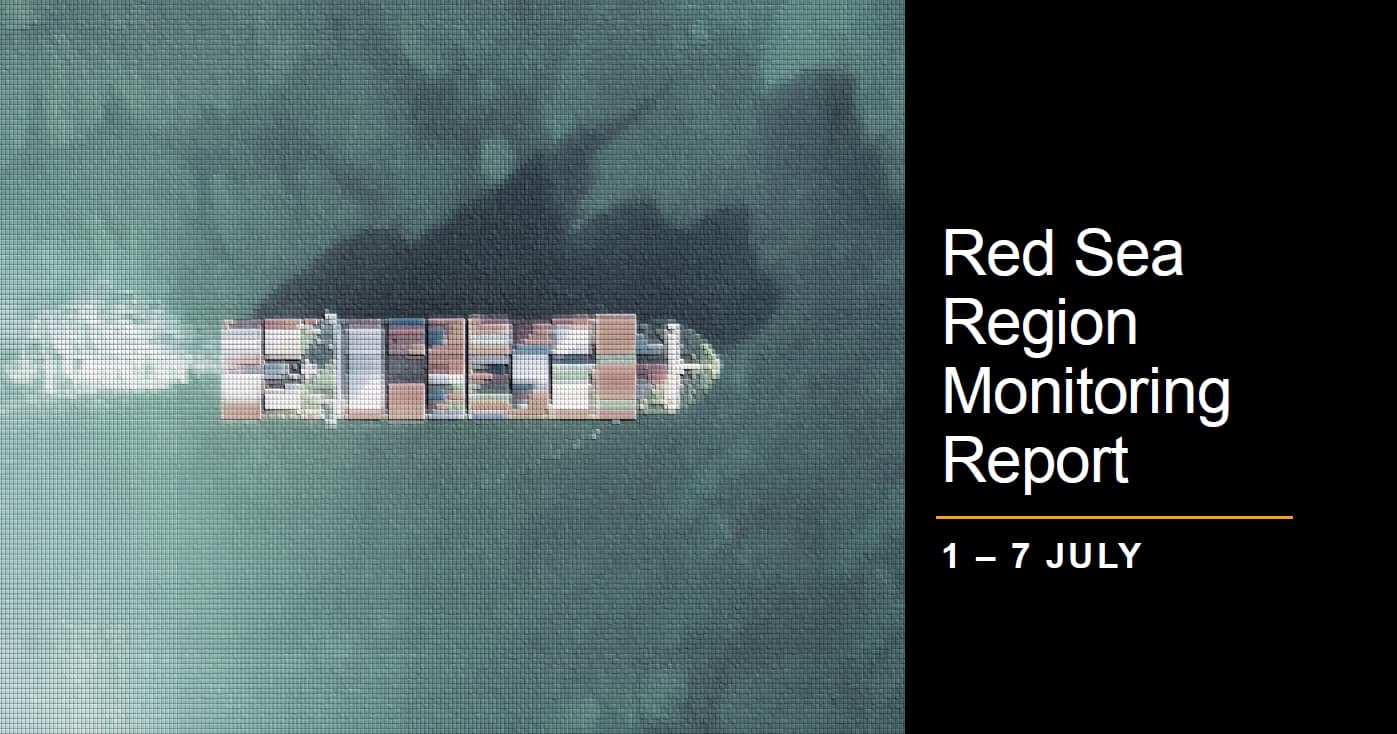KEY DEVELOPMENTS – COMMERCIAL INCIDENTS
During the monitoring period 11-17 March Regal Maritime Solutions (RMS) identified the following incidents in the Red Sea and Gulf of Aden region, obtained from a variety of open sources including UKMTO and the United States (US) military:
MISSILE ATTACK: On 11 March approximately 71NM south-west of Saleef, Yemen the MV Pinocchio, a Singaporean-owned, Liberian-flagged ship reported an explosion in the vicinity of the vessel’s location. The vessel and crew were reported safe.
PIRACY INCIDENT: On 11 March approximately 600NM east of Mogadishu, Somalia the Bangladesh flagged MV Abdullah reported it had been boarded by multiple individuals from two craft, one large and one small who had acquired unauthorised control of the vessel. The individuals are believed to belong to a Pirate Action Group (PAG).
MISSILE ATTACK: On 14 March at approximately 0418 UTC a commercial vessel reported an explosion in the distance astern of the vessel. The vessel and crew were reported safe and continued to its next port of call.
MISSILE ATTACK: On 14 March at approximately 50NM south-west of Al Hudaydah, Yemen, two missiles were reported as flying over a commercial vessel followed by two blasts in the distance. The vessel reported no damage or injury to the crew and proceeded to its next port of call.
MISSILE ATTACK: On 15 March approximately 76NM west of Al Hudaydah, Yemen, a commercial vessel was reportedly struck by a missile and believed to have sustained some damage. The vessel proceeded to its next port of call. Upon later inspection it appeared that the vessel had not been damaged in the incident.
MISSILE ATTACK: On 15 March approximately 65NM west of Al Hudaydah, Yemen, a Marshall Islands-flagged liquefied petroleum gas (LPG) tanker reported an explosion in the distance off the vessel’s starboard beam resulting in no damage to the vessel or injuries to its crew. The vessel proceeded to its next port of call.
MISSILE ATTACK: On 17 March a merchant vessel reported an explosion in close proximity to the vessel resulting in no damage or injuries to the crew. The vessel continued to its next port of call.
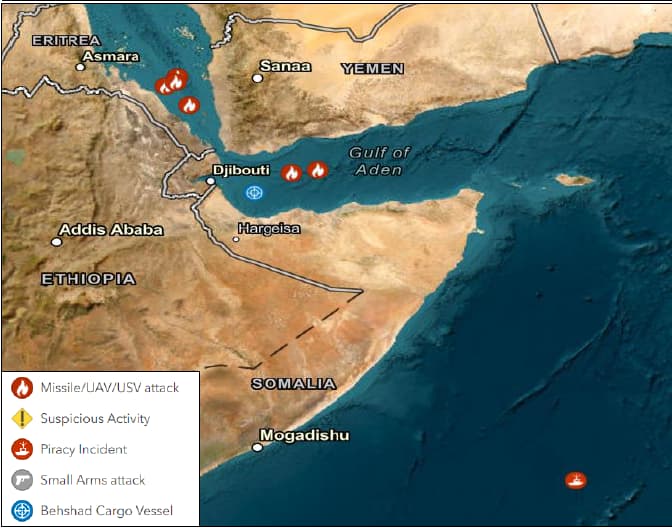
KEY DEVELOPMENTS – MILITARY ACTIVITY
During the monitoring period 11-17 March RMS identified the following incidents involving US coalition forces in the Red Sea and Gulf of Aden region, obtained from military and open sources:
MISSILE ATTACK: On 11 March between 0850 and 1250 local time, Houthi militants fired two anti-ship ballistic missiles (ASBMs) from Houthi-controlled territory into the Red Sea toward MV Pinocchio, a Singaporean-owned, Liberian-flagged ship. The missiles did not impact the vessel and no injuries or damage was reported.
UUV/MISSILE INTERCEPT: On 11 March between 1450 and 2330 local time, US forces conducted six pre-emptive strikes destroying an unmanned underwater vessel (UUV) and 18 anti-ship missiles in Houthi controlled territory of Yemen considered an imminent threat to vessels in the region.
MISSILE ATTACK: On 12 March between 0200 and 0430 local time Houthi militants launched one close-range ballistic missile from Houthi-controlled areas of Yemen toward US warship, USS Laboon in the Red Sea. The missile did not impact the vessel and no injuries or damage were reported.
UAV INTERCEPT: On 12 March, US led coalition warships successfully engaged and destroyed two unmanned aerial vehicles (UAVs) launched from a Houthi-controlled area of Yemen, and determined an imminent threat to vessels in the region.
MISSILE ATTACK: On 13 March between 0200 and 0450 local time, one anti-ship ballistic missile was launched from Houthi-controlled areas of Yemen into the Gulf of Aden. The missile did not impact or cause damage to any vessels in the vicinity of the incident or injuries to their crew.
UAV INTERCEPT: On 13 March, US forces conducted pre-emptive strikes destroying four unmanned aerial vehicles (UAVs) and one surface-to-air missile in Houthi-controlled areas of Yemen.
MISSILE ATTACK: Over 14-15 March, between 0650 and 0040 local time, Houthi militants launched two anti-ship ballistic missiles (ASBMs) from Houthi-controlled territory in Yemen toward the Gulf of Aden alongside another two ASBMs launched towards the Red Sea. There was no reported damage or injuries amongst vessels in the vicinity of the target sites including amongst US coalition vessels.
UAV INTERCEPT: Between 14-15 March, US forces identified and destroyed nine anti-ship missiles and two UAV in pre-emotive strikes on Houthi-controlled areas of Yemen considered an imminent threat to vessels and coalition warships in the region.
MISSILE ATTACK: On 15 March between 0830 and 2250 local time Houthi militants launched three anti-ship ballistic missiles from Yemen toward the Red Sea. There were no injuries or damage vessels in the region.
UAV INTERCEPT: On 16 March, between 0750 and 0815 local time two unmanned Aerial vehicles (UAV) were launched from Houthi-controlled territory toward the Red Sea. US forces intercepted and destroyed one UAV whilst the other is believed to have crashed into the Red Sea. There were no reports of damage or injuries from vessels in the vicinity.
USV/UAV INTERCEPT: On 16 March between 2100 and 2230 local time, US naval forces conducted pre-emptive strikes on five unmanned surface vessels (USVs) and one UAV in Houthi-controlled areas of Yemen, considered as posing an imminent threat to commercial vessels in the region.
COORDINATED MILITARY ACTION: Between 15-16 March the Indian navy successfully recaptured the bulk carrier MV Ruen after it had been pirated by Somali pirates in December 2023. The Indian warship Kolkata was able to coerce the 35 pirates to surrender resulting in their detention and the safe recovery of the 17 crew.
KEY DEVELOPMENTS – HOUTHI MISSILE STATISTICS
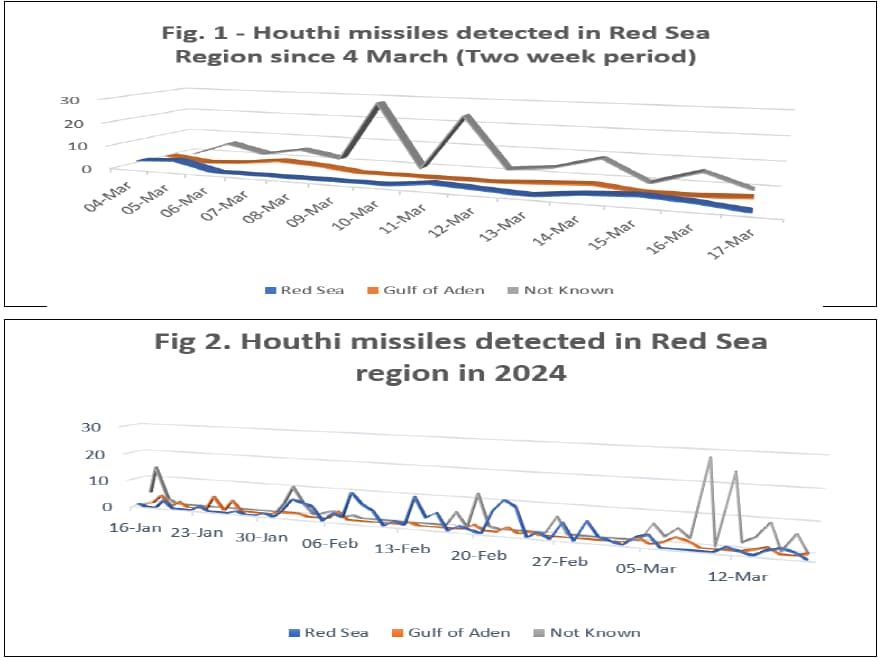
Figures 1 and 2 identifies the number of missiles, UAV, USVs and UUVs launched, or prepared to be imminently launched, by Houthi militants from Yemen targeting both commercial and naval vessels in the Red Sea and Gulf of Aden regions from data available from UKMTO, the US military and OSINT sources. Both figures have incorporated statistics from vessels hit, near misses and pre-emptive strikes on-land in Yemen by US-led Coalition forces but not those resulting from large scale coordinated military action. In some cases the destined target of Houthi weapons destroyed on-land in Yemen cannot not be verified and has therefore been categorised as ‘Not Known’ (NK). Where no dates are provided there were no reported incidents or data available for that period.
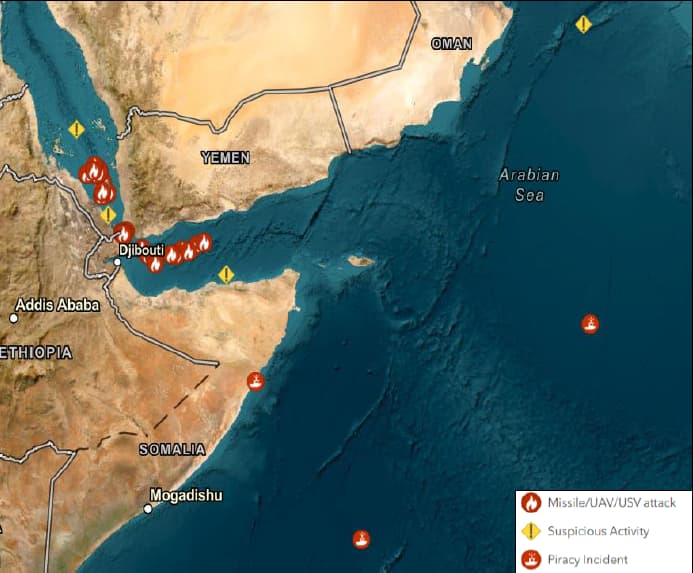
1 Jan – 17 Mar 2024
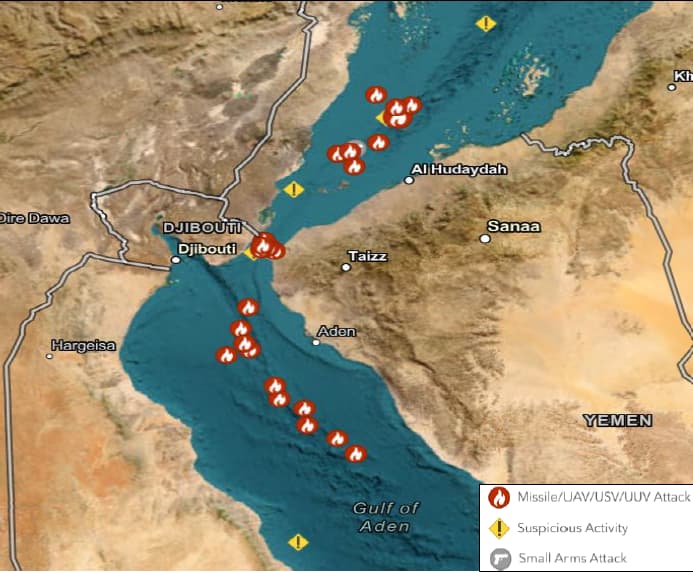
1 Jan – 17 Mar 2024
REGIONAL DEVELOPMENTS
During the monitoring period 11-17 March RMS identified the following key regional developments:
The Houthi leader Abdul Malik al-Houthi, reasserted the group’s ambitions to escalate their operations targeting vessels not only in the Arabian Sea, the Red Sea and the Gulf of Aden, but also the Indian Ocean towards the Cape of Good Hope in South Africa in an effort to apply further pressure on Israel and its international partners by targeting Israel-linked vessels. The announcement comes as Russian state media reported on 14 March that Houthi militants tested a new hypersonic missile which they will be adding to their arsenal with the intent of using against commercial shipping.
The US government is increasing its efforts to identify, track and intercept Iranian weapons being smuggled to Houthi militants in Yemen through predominately maritime means, which is being used to attack commercial shipping in the region. Maritime smuggling from Iran has been identified as largely originating from the Iranian ports of Jask in the Gulf of Oman and Bandar Abbas in the strait of Hormuz to the Yemeni port of Al Hudaydah, as well as overland routes via Oman and territory controlled by the Yemeni Internationally Recognised Government (IRG)
The US and UK governments have called on the United Nations (UN) to do more to prevent the smuggling of Iranian weapon components to Yemeni ports controlled by Houthi militants by having the UN verification and inspection mechanism (UNVIM) to be further empowered to conduct the task. Meanwhile, Chinese and Russian officials insist that neither the US or UK have UN authority to continue to conduct military strikes on Houthi controlled sites in Yemen.
According to both US and Iranian officials, both countries held unofficial talks in January 2024 in Oman regarding Iran’s continued nuclear ambitions and the Houthi movements attacks on commercial shipping in the Red Sea and Gulf of Aden region. The US reportedly tried to convince Iran to use its influence over the Houthi movement to end attacks on ships in the Red Sea. The act appears to demonstrated the US President Joe Biden’s ambitions to continue to utilise diplomatic channels in addition its military deterrent to avoid prevent regional escalation.
Talks between Israel and Hamas continue with Qatari officials mediating. Whilst there is no current agreement, talks are expected to be drawn out over the coming weeks due to Hamas negotiators inability to reach Hamas operators on the ground in Gaza to discuss the details of the proposals. Hamas is seeking the release of hundreds of Palestinian prisoners being held by Israel and a permanent ceasefire in exchange for 40 Israeli hostages still currently being held in Gaza. Israel has vehemently ruled out a permanent ceasefire.
The Iranian Behshad intelligence collection vessel is located in the vicinity of coordinates 11°13’23.6″N,044°22’36.1″E approxiamltey40NM north east of Lughaya, Somalia at the time of this report.
The Indian warship Kolkata successfully recaptured the pirated vessel, the MV Ruen in an operation lasting approximately 40 hours on 15-16 March. The PAG opened fire on the Indian warship who responded with the minimum force necessary to neutralise the threat resulting in the PAGs eventual surrender resulting in the recovery of the vessel and rescue of the 17 crew aboard. No crew were injured in the operation. The vessel was recaptured approximately 1400NM from the Indian coast.
Information from EUNAVFOR ATLANTA suggests that there maybe five Pirate Action Groups (PAGs) operating in the eastern Gulf of Aden and the Somali Basin, with an operational range extending north of Eyl up to a distance of 1000 nautical miles.
EUNAVFOR Operation ATALANTA have identified several possible pirate camps on the Somali Coastline situated between Xaafuun and the village of Garacad, with a hot spot north of Eyl. Pirates are likely operating from Mother Boats, scouting for targets in areas with favourable sea conditions for boarding attempts of commercial shipping.
The typical pirate strategy involves the hijacking of a dhow, which is subsequently utilised by PAGs as their mother ship. PAGs will then dissimulate amongst regular maritime traffic and deploy skiffs/small crafts from the mother ship to attack vessels navigating as far as 600NM or more off the East Somali coast. If the targeted vessel appear unable to repel the attack, pirates may opt to board the ship. Once a vessel is seized, it is taken to the Somali coast and held there while ransom negotiations continue.
ASSESSMENT
Houthi attacks, and rate of attacks on commercial and military vessels in the Red Sea and Gulf of Aden will likely continue at their present rate, in particular those with links, and/or tenuous links to Israel, the US and the UK.
The Houthis ability to strike vessels further afield such as those in the Indian Ocean headed to the Cape of Good Hope is unlikely at present, however their intent demonstrates their ambition to increase pressure on Israel and the US and its allies.
Reports of the Houthi’s hypersonic missile test remains uncorroborated. Nonetheless their ambition to possess and manufacture such a weapon would pose a major challenge to commercial vessels and military warships in the region which would test coalition air defence systems.
Any ceasefire between Israel and Hamas, would likely see a pause in attacks by Houthis on commercial shipping.
Iran will continue to smuggle weapon components to Houthi militants via Al-Hudaydah port, shipping vessels and through arms smuggling networks within the territory controlled by Yemen’s internationally recognised government (IRG).
Iran will continue to monitor and restrain Houthi ambition where necessary, should it look to compromise Iran’s wider strategic objectives in the region, or provoke direct US or Israeli military action against its immediate interests.
The US and its partners will continue to conduct pre-emptive strikes against Houthi targets on-land in an attempt to degrade Houthi military capability.
The US will look to intensify efforts to intercept vessels smuggling weapon components from Iran to the Houthis in Yemen and will increasingly work with its allies to expand their intelligence collection capability to enhance interdiction operations, as well as increase on-the-ground intelligence collection activities on Houthi weapon sites and capabilities in Yemen.
The US government will continue to pursue a diplomatic solution for the Israel-Hamas conflict with regional partners in an attempt to dissuade wider escalation in the region. The US and regional partners will continue to pursue a ceasefire between Israel and Hamas in an attempt to alleviate pressure on the humanitarian situation in Gaza.
Piracy incidents around the Horn of Africa is expected to increase as a consequence of Somali fishing policy and opportunism by Somali based Piracy Action Groups (PAGs) seeking to take advantage of the security vacuum along the east Africa coastline as a consequence of Houthi attacks in the Red Sea region. The conclusion of the monsoon season is expected to facilitate pirate-boarding activities and there is a notable likelihood of PAGs deploying into the Indian Ocean in search of such opportunities.
RECOMMENDATIONS
Avoid being in vicinity of Iranian Behshad vessel.
Be aware of potential US, coalition or Israeli Navy activity nearby in north of Red Sea, Bab-al-Mandab strait and Gulf of Aden.
Vessels operating in the Indian Ocean area are urged to heighten their vigilance due to increased likelihood of Pirate Activity Groups (PAGs) operating in the area.
Report any Suspicious Sightings and be aware of the risk of Unmanned aerial Vehicle (UAV) / drone and Uncrewed Surface Vehicle (USV) attack.
Consider utilising a digital monitoring system, which incorporates UAV/UUV drone monitoring to warn of potential attack and use of physical barriers, such as nets and underwater barriers, that can be deployed to prevent UUVs from approaching a ship. These barriers can entangle or obstruct the movement of a UUV.
Ensure crew conduct drills and training exercises to respond to UUV threats so that they are well-prepared to take appropriate action in the event of an incident.
Follow guidance on loitering munitions as per the OCIMF website: https://www.ocimf.org/publications/information-papers/loitering-munitions-%E2%80%93-the-threat-to-merchant-ships
Implement and review BMP5 in particular section 2, which describes non-piracy threats and the Global Anti-Piracy Guide.
Consider mentioning vessel location to Flag Authorities.
Inform UKMTO/MSCHoA of vessel movements.
Ensure radar is kept on.
Communicate with local agents for any local information or intelligence.
Keep VHF Ch16 on and pay attention to advisories. Ensure strict surveillance of communications and establish communication with all approaching vessels.
Do not allow small boats to approach or dock.
Ensure there is Hard Cover available if on deck and that it is accessible.
Ensure a Secondary Muster Station is considered and identified to crew and not just the citadel.
Maintain Bridge Watches. (Please be aware at night, small, slow vessels without a wake are difficult to detect on radar). Keep Traffic on Upper Deck to a minimum
Ensure all fire-fighting equipment is checked and available for immediate use. Including the emergency fire pump and that relevant maintenance has been conducted.

